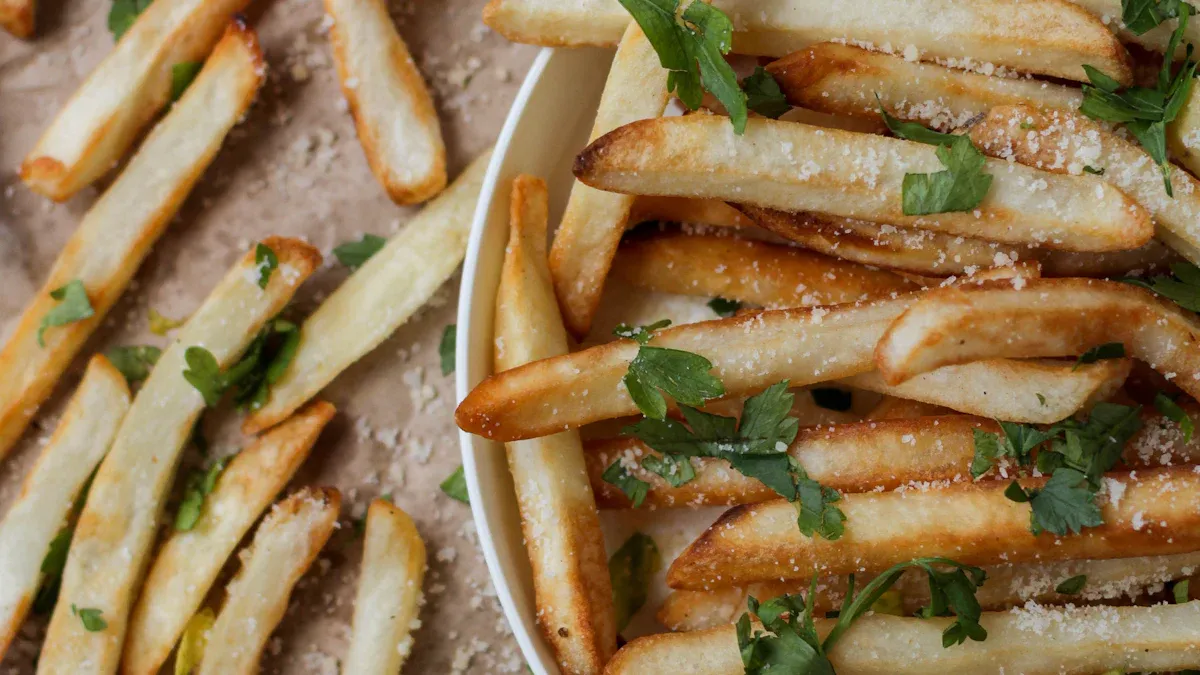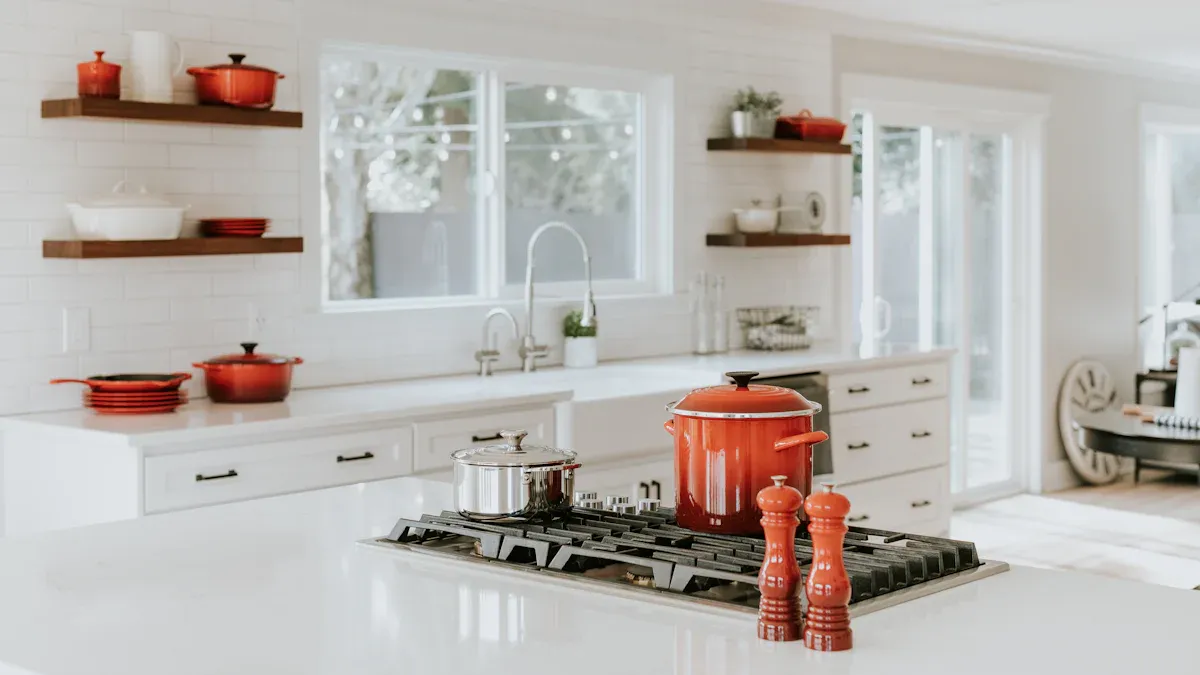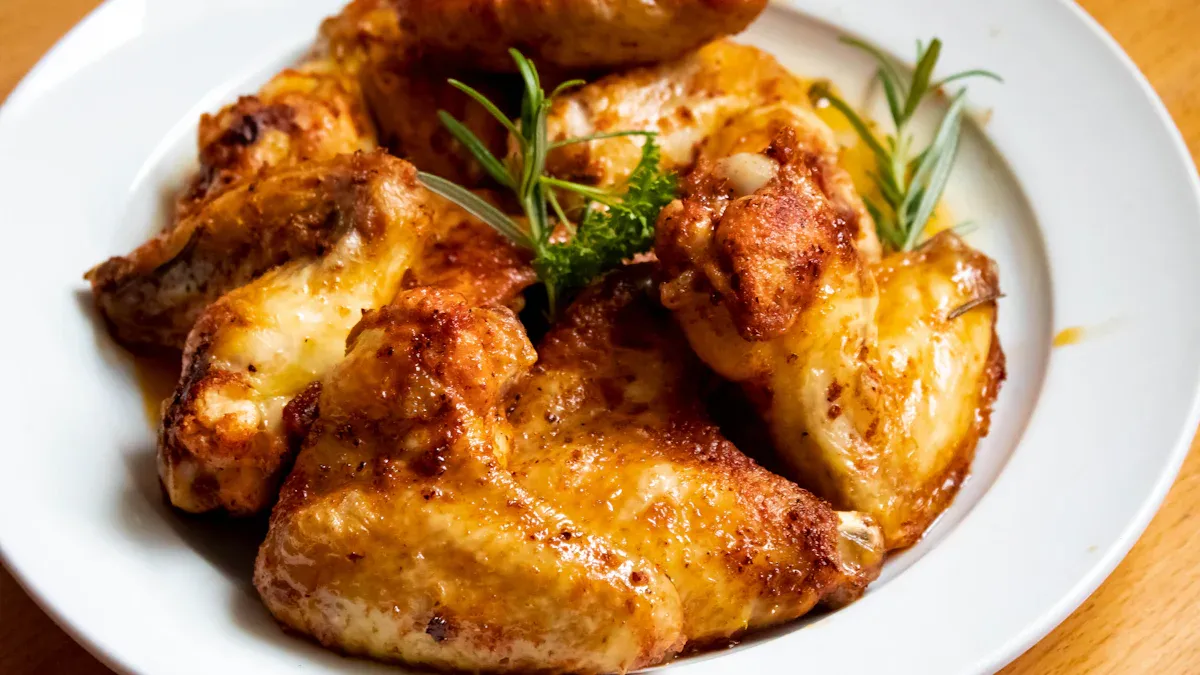
Air fryers, such as the Electric Oil Free Fryer, have revolutionized home cooking by providing a healthier and faster way to prepare meals. These Electric Deep Smart Air Fryers use rapid air circulation to cook food evenly and efficiently, making them ideal for a variety of dishes.
An Air Fryer Automatic Large Capacity utilizes a high-powered fan to bake food at high temperatures, ensuring quick and effective cooking for families or gatherings.
With reduced oil usage, an Air Fryer For Different Food promotes better heart health and supports weight management, making it a must-have kitchen appliance.
Setting Up Your Air Fryer For Different Food
Unboxing and Cleaning
Unboxing your air fryer is an exciting first step, but it’s important to start with proper care. Begin by inspecting all components to ensure nothing is damaged during shipping. Once everything checks out, clean each part with warm, soapy water before using it for the first time. This removes any residue from manufacturing.
After every use, hand wash removable parts like the basket and tray to prevent grease buildup. Regular cleaning keeps your air fryer running efficiently and ensures food safety. Avoid submerging the main body in water; instead, wipe it down with a damp cloth. For a deeper clean, remove grates and drawers weekly to tackle stuck-on food particles.
Tip: Hand washing components instead of using a dishwasher helps prolong their lifespan.
Placement and Safety Tips
Where you place your air fryer matters for both safety and performance. Choose a flat, heat-resistant surface with plenty of ventilation around the appliance. Keep it away from walls or cabinets to prevent overheating.
Ensure the cord is securely plugged into a grounded outlet, and avoid using extension cords. Never operate the air fryer near water sources, as this could lead to electrical hazards.
Safety Reminder: Always supervise the air fryer while it’s in use, especially if children are nearby.
Understanding Controls and Features
Modern air fryers come with a variety of controls and features that make cooking easier. Familiarize yourself with the temperature and timer settings, as these are key to achieving perfect results for different foods. For example, asparagus cooks best at 400°F for 7-10 minutes, while chicken breasts need 360°F for 20-25 minutes.
Here’s a quick reference table for common foods:
| Food type | Preparation | Temperature | Time |
|---|---|---|---|
| Asparagus | Whole, trimmed | 400°F | 7-10 minutes |
| Broccoli | Cut in 1” florets | 375°F | 8-10 minutes |
| Green beans | Trimmed | 380°F | 10-12 minutes |
| Potatoes (wedges) | Cut in 1” wedges | 400°F | 20-25 minutes |
| Chicken breasts | Seasoned | 360°F | 20-25 minutes |
| Salmon | Seasoned | 380°F | 12-15 minutes |
| Bacon | None | 375°F | 8-10 minutes |
| Steak | Seasoned | 400°F (varies) | 10-20 minutes |
Take time to explore additional features like pre-programmed settings for specific dishes. These can save time and simplify the cooking process.
Preparing Food for Air Fryer Cooking
Cleaning and Cutting Ingredients
Proper preparation starts with clean and evenly cut ingredients. Washing fruits, vegetables, and proteins thoroughly removes dirt and bacteria. For safety, always sanitize surfaces and wash hands before and after handling food. Using separate cutting boards for raw and cooked items prevents cross-contamination.
Cutting ingredients into uniform sizes ensures even cooking in the air fryer. For example, chopping potatoes into 1-inch wedges helps them cook evenly and achieve a crispy texture. Similarly, trimming vegetables like asparagus or green beans ensures they fit well in the basket and cook uniformly.
| Safety Step | Description |
|---|---|
| Clean | Wash hands and sanitize surfaces before and after food preparation. |
| Separate | Avoid cross-contamination by using separate cutting boards for raw and cooked foods. |
| Cook | Ensure food reaches safe minimum internal temperatures: Fish at 145°F, Beef at 145°F, Ground meat at 160°F, Poultry at 165°F. |
| Chill | Refrigerate leftovers within 2 hours to prevent foodborne illness. |
Seasoning and Marinating Techniques
Seasoning is key to enhancing the flavor of air-fried dishes. Generously seasoning proteins and vegetables ensures every bite is flavorful. Herbs and spices like paprika, garlic powder, and rosemary add depth to the taste. A light coat of oil helps spices stick and creates a crispy exterior.
Marinating proteins like chicken or beef for at least 30 minutes infuses them with flavor. For vegetables, tossing them in olive oil and seasoning before air frying works wonders. Uniform seasoning ensures consistent taste and texture.
Tip: Cut ingredients into uniform pieces, season generously, and use fresh herbs for the best results.
Using Oil: Best Practices
Using oil sparingly is one of the biggest advantages of an air fryer. Unlike deep frying, which requires over 3 cups of oil, air frying needs less than a tablespoon. This significantly reduces fat content while still delivering crispy results.
Research shows that air frying emits only 0.6 micrograms of harmful particles per cubic meter, compared to 92.9 micrograms from pan-frying. This makes it a healthier and safer cooking method. Opt for oils with high smoke points, like avocado or canola oil, and avoid aerosol sprays, which can damage the air fryer’s non-stick coating.
Note: Using small amounts of oil not only reduces fat but also helps manage weight and lowers the risk of harmful chemicals.
Air Fryer Settings and Cooking Times
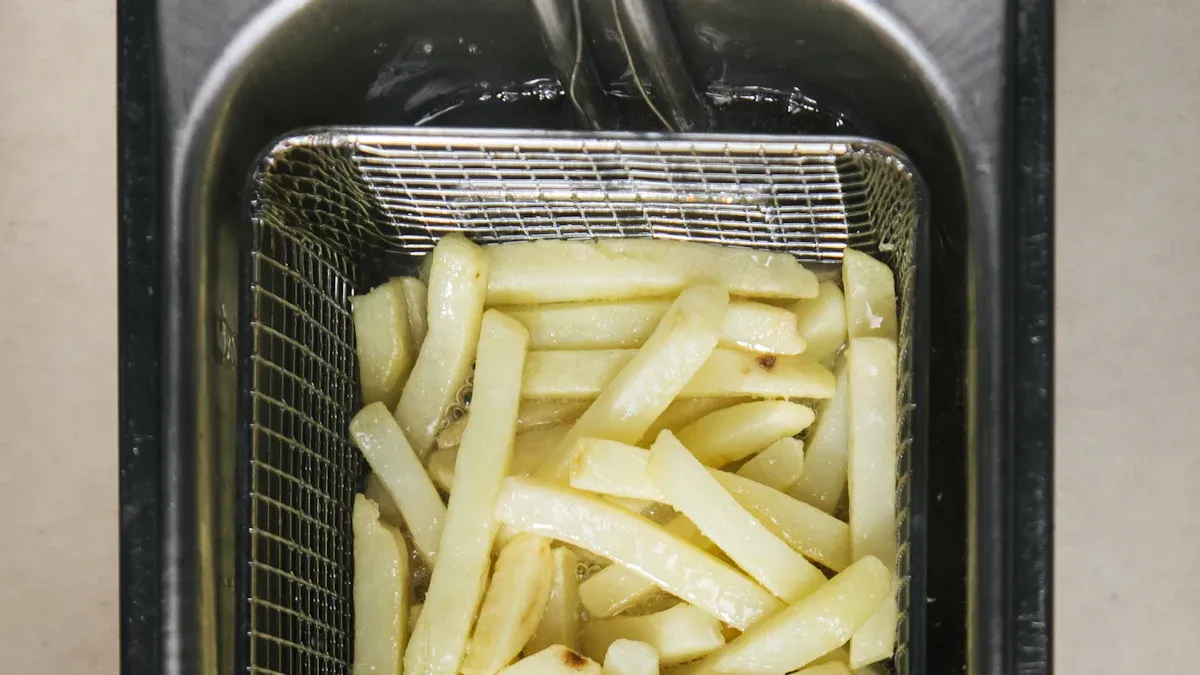
Temperature and Time for Proteins
Cooking proteins in an air fryer requires precision to achieve the perfect texture and flavor. The temperature control feature in most air fryers allows users to adjust settings based on the type of protein being cooked. For example, chicken breasts cook best at 360°F for 20-25 minutes, while salmon requires 380°F for 12-15 minutes. Steak, depending on its thickness, cooks well at 400°F for 10-20 minutes.
| Food Type | Temperature | Time |
|---|---|---|
| Chicken breasts | 360°F | 20-25 minutes |
| Salmon | 380°F | 12-15 minutes |
| Steak | 400°F (varies) | 10-20 minutes |
To ensure even cooking, check the food halfway through and adjust the time for thicker cuts. Most meats cook well at 375°F, but always monitor the internal temperature for safety.
Tip: Use a meat thermometer to confirm doneness. Chicken should reach 165°F, while beef and fish should hit 145°F.
Cooking Vegetables in an Air Fryer
Vegetables become crispy and flavorful in an air fryer when cooked at the right temperature and time. For instance, broccoli cooks at 400°F for 6 minutes, while potatoes need 425°F for 20 minutes. Uniformly cutting vegetables ensures even cooking and prevents burning.
| Veggies | Temperature | Time |
|---|---|---|
| Brussel sprouts | 425°F | 10 minutes |
| Broccoli | 400°F | 6 minutes |
| Potatoes | 425°F | 20 minutes |
| Zucchini | 350°F | 12 minutes |

Toss vegetables in a light coat of oil and seasoning before cooking for the best results.
Frozen Foods and Snacks Settings
Air fryers excel at transforming frozen foods into crispy, golden snacks. Items like mozzarella sticks, fries, and chicken nuggets cook evenly with minimal oil. The rapid air circulation mimics a convection oven, making it ideal for these treats.
| Food Type | Minimum Internal Temperature (°C) |
|---|---|
| Minced Meat | 70 |
| Fish | 60 |
| Poultry | 74 |
| Medium-Rare Lamb | 52 |
| Medium-Rare Beef | 57 |
| Pork | 63 |
Note: Always preheat the air fryer for frozen foods to ensure even cooking and a crispy texture.
Adjusting for Homemade Recipes
Homemade recipes may require some trial and error to perfect in an air fryer. Start by using general guidelines for similar foods and adjust the temperature or time as needed. For example, if baking homemade fries, begin with 400°F for 20 minutes and check halfway through.
Experimenting with settings helps achieve the desired texture and flavor. Keep notes on what works best for your favorite recipes.
Pro Tip: Avoid overcrowding the basket to allow hot air to circulate freely. This ensures even cooking for all items.
Cooking Process in an Air Fryer
Preheating: When and Why
Preheating an air fryer might seem like an extra step, but it’s worth the effort. It ensures even cooking, helps achieve crispy textures, and reduces overall cooking time. Think of it like preheating an oven—it creates a consistent temperature before the food goes in. This is especially important for recipes that require precise cooking, like chicken wings or homemade fries.
Most air fryers have a preheat function, but if yours doesn’t, simply set the temperature and let it run for 3-5 minutes before adding food. Skipping this step can lead to uneven results, with some parts undercooked while others overcook. Preheating is a small step that makes a big difference in the final dish.
Tip: Always preheat when cooking proteins or frozen foods to lock in flavor and texture.
Placing Food: Avoiding Overcrowding
How you arrange food in the air fryer basket matters. Overcrowding blocks hot air from circulating properly, leading to uneven cooking. For the best results, place food in a single layer with some space between pieces. This allows the air to flow freely and cook everything evenly.
If you’re cooking for a larger group, consider cooking in batches. While it might take a little longer, the results will be worth it. Overcrowding can leave some pieces soggy instead of crispy. For items like fries or chicken nuggets, spreading them out ensures every piece gets that golden, crunchy finish.
Pro Tip: Use a rack accessory to cook multiple layers without overcrowding the basket.
Flipping and Shaking Techniques
Flipping and shaking are essential for even cooking in an air fryer. Shaking the basket halfway through redistributes the food, ensuring all sides cook evenly. This is especially important for smaller items like fries or nuggets, as it prevents sticking and promotes uniform crispiness.
For larger items like chicken breasts or steak, flipping them ensures both sides cook to perfection. Some recipes recommend flipping or shaking every 5 minutes, so it’s a good idea to stay close to the air fryer while cooking.
| Technique | Description |
|---|---|
| Shaking the basket | Shake halfway through cooking to redistribute food and ensure even results. |
| Shake or Flip Food | Flip or shake every 5 minutes for uniform crisping and browning. |
These techniques might seem simple, but they make a noticeable difference in the texture and taste of your dishes. Whether you’re cooking vegetables, proteins, or snacks, a quick shake or flip can elevate the final result.
Removing and Serving Air-Fried Food
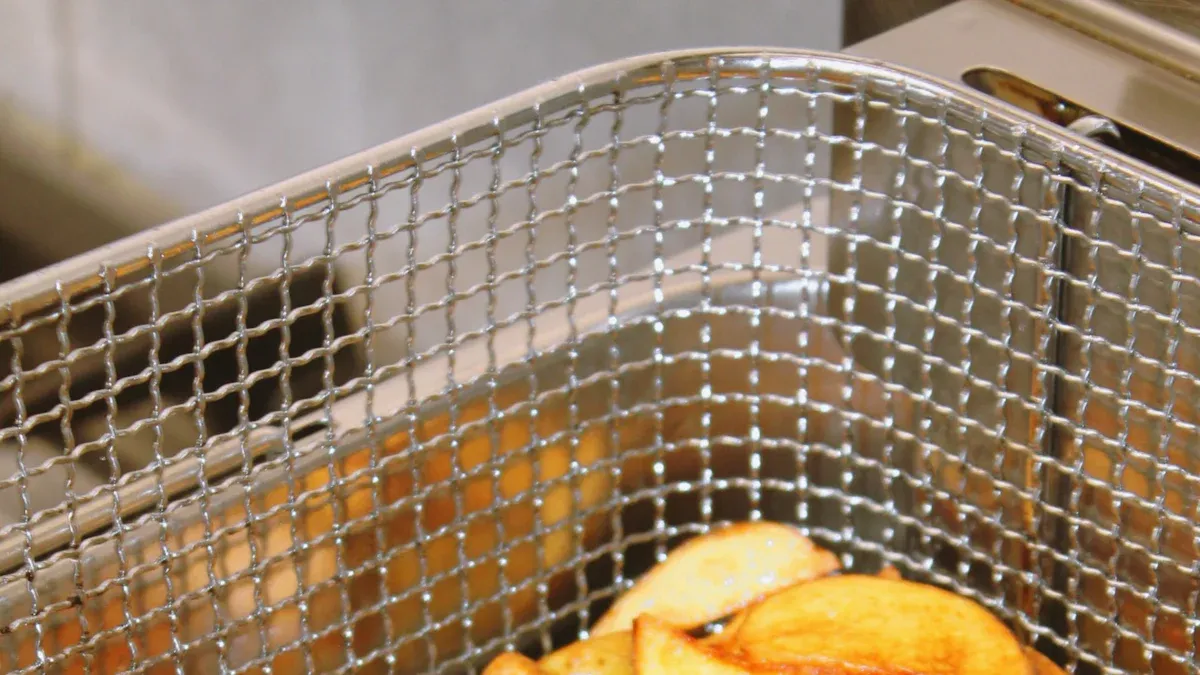
Safe Removal Tools
Removing food from an air fryer can be tricky without the right tools. Using heat-resistant tongs or silicone spatulas prevents burns and protects the air fryer’s non-stick coating. Avoid metal utensils, as they can scratch the surface. For smaller items like fries or nuggets, a slotted spoon works well to scoop them out without damaging the basket.
Food safety is just as important as convenience. Always wash hands for at least 20 seconds before and after handling food. Clean and sanitize surfaces to avoid contamination. Never place cooked food on the same plate that held raw ingredients.
| Safety Tip | Description |
|---|---|
| Clean | Wash hands and sanitize surfaces before and after food preparation. |
| Separate | Use separate plates and cutting boards for raw and cooked food. |
| Cook | Avoid overcrowding and check internal temperatures with a food thermometer. |
| Chill | Refrigerate leftovers within 2 hours to prevent bacterial growth. |
Keeping Food Warm
Sometimes, food finishes cooking before everyone is ready to eat. To keep it warm, place the cooked food in a preheated oven at 200°F. Cover it loosely with aluminum foil to retain heat without making it soggy. If the air fryer has a “keep warm” function, use it to maintain the perfect serving temperature.
Avoid leaving food out for too long. Bacteria can grow quickly when food stays in the “Danger Zone” between 40°F and 140°F. Refrigerate leftovers promptly to ensure safety.
Presentation Tips
Presentation makes a meal more enjoyable. Arrange air-fried food neatly on a plate or serving tray. Garnish with fresh herbs like parsley or cilantro for a pop of color. For dipping sauces, use small bowls or ramekins to keep the plate tidy.
Adding a sprinkle of seasoning or a drizzle of olive oil can enhance both flavor and appearance. Whether it’s crispy fries or golden chicken wings, a little effort in presentation can make the meal feel special.
Tip: Serve food immediately after cooking for the best texture and taste.
Cleaning and Maintaining Your Air Fryer
Cleaning the Basket and Tray
Keeping the basket and tray clean is essential for maintaining your air fryer’s performance. After each use, wash these components with warm, soapy water and a non-abrasive sponge. This prevents grease and food particles from building up. For stubborn residue, soak the basket and tray in soapy water for 15-20 minutes before scrubbing with a soft brush.
Once a month, perform a deep clean. Turn off and unplug the air fryer, allowing it to cool completely. Remove the basket and tray, then soak them in hot, soapy water for 30 minutes to an hour. Use a soft sponge to scrub away any remaining residue. Avoid using metal utensils or abrasive cleaners, as they can damage the non-stick coating.
Tip: Wipe out excess oil with a paper towel before it solidifies to make cleaning easier.
Wiping Down the Interior and Exterior
The interior and exterior of the air fryer also need regular attention. After unplugging and cooling the appliance, wipe down the interior with a damp cloth to remove grease splatters. For the exterior, use a soft, damp cloth to clean fingerprints and dust.
If food particles are stuck inside, use a soft brush or toothbrush to gently dislodge them. Avoid using water directly on the heating element. Keeping the air fryer clean inside and out ensures it runs efficiently and looks great on your countertop.
Preventing Build-Up and Odors
Preventing odors and grease build-up starts with regular maintenance. Clean the air fryer as soon as it cools after cooking. If odors persist, place a mixture of water and lemon juice in the basket and run the air fryer at 350°F for 3-5 minutes. This freshens the interior and removes lingering smells.
Pro Tip: Avoid cooking overly greasy foods frequently, as they can lead to faster build-up. Regular cleaning keeps your air fryer smelling fresh and performing at its best.
Tips for Best Results with Air Fryer For Different Food
Avoid Overcrowding
Overcrowding the air fryer basket can lead to uneven cooking. When food is packed too tightly, hot air struggles to circulate properly. This results in some pieces being undercooked while others may burn. To avoid this, place food in a single layer with enough space between each piece. If cooking for a larger group, it’s better to cook in batches. While it might take a little extra time, the results will be worth it.
Pro Tip: Use a rack accessory to create multiple layers without blocking airflow. This allows you to cook more food at once without sacrificing quality.
Use Minimal Oil
One of the biggest advantages of an air fryer is its ability to cook with very little oil. A small amount—often less than a tablespoon—is enough to achieve crispy, golden results. Excessive oil can cause smoke and leave food greasy. Instead, lightly coat ingredients with oil using a brush or spray bottle.
- Benefits of using minimal oil:
- Reduces fat content while maintaining flavor.
- Prevents greasy textures and smoke during cooking.
The air fryer technology allows for crispy and tender food textures with significantly less oil compared to traditional frying methods.
Monitor Food Closely
Keeping an eye on food while it cooks ensures the best results. Air fryers work quickly, so it’s easy for food to overcook if left unattended. Check the progress halfway through and adjust the time or temperature if needed. For smaller items like fries or nuggets, shaking the basket helps cook them evenly.
Tip: Use a timer or set reminders to avoid overcooking. This is especially helpful when trying new recipes.
Experiment with Recipes
An air fryer opens up endless possibilities for creativity in the kitchen. Don’t hesitate to try new recipes or tweak existing ones. Start with simple dishes like roasted vegetables or chicken wings, then move on to more complex meals. Adjusting the temperature and time for homemade recipes might take a few tries, but it’s a fun way to discover what works best.
Experimenting also helps you understand how the air fryer handles different foods. Whether it’s baking, roasting, or frying, the versatility of an air fryer for different food makes it a valuable tool for any home cook.
Pro Tip: Keep a notebook to jot down successful recipes and settings for future reference.
Mastering air fryer cooking is simple with the right steps. From preheating to flipping techniques, each step ensures delicious results. Air fryers save time and energy, requiring less preheating than ovens.
| Statistic | Description |
|---|---|
| 53% | Users value cost-efficiency. |
| 46% | Appreciate faster cooking times. |
Experiment with recipes and enjoy healthier meals with less oil. Air fryers make cooking fun, fast, and flavorful!
FAQ
How much oil should you use in an air fryer?
A tablespoon or less works best. Lightly coat food with oil using a brush or spray bottle for crispy results.
Can you cook multiple foods at once in an air fryer?
Yes, but avoid overcrowding. Use a rack accessory to separate layers and ensure proper airflow for even cooking.
Do you need to preheat an air fryer every time?
Not always. Preheating helps with crispy textures, especially for proteins and frozen foods. Check your recipe for specific instructions.
Tip: Preheat for 3-5 minutes if unsure. It’s a small step that makes a big difference!
